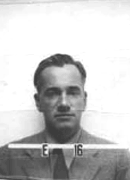Otto Frisch
| Otto Robert Frisch | |
|---|---|

Otto Robert Frisch's wartime Los Alamos ID badge photo.
|
|
| Born |
1 October 1904 Vienna, Austria-Hungary |
| Died | 22 September 1979 (aged 74) Cambridge, United Kingdom |
| Nationality | Austrian/British |
| Fields | Physics |
| Known for | Atomic bomb |
| Influences | Rudolf Peierls |
| Notable awards | Fellow of the Royal Society |
| Signature | |
Otto Robert Frisch FRS (1 October 1904 – 22 September 1979) was an Austrian-British physicist. With his collaborator Rudolf Peierls he designed the first theoretical mechanism for the detonation of an atomic bomb in 1940.
Frisch was Jewish, born in Vienna, Austria, in 1904, the son of Justinian Frisch, a painter, and Auguste Meitner Frisch, a concert pianist. He himself was talented at both but also shared his aunt Lise Meitner's love of physics and commenced a period of study at the University of Vienna, graduating in 1926 with some work on the effect of the newly discovered electron on salts. After some years working in relatively obscure laboratories in Germany, Frisch obtained a position in Hamburg under the Nobel Prize-winning scientist Otto Stern. Here he produced work on the diffraction of atoms (using crystal surfaces) and also proved that the magnetic moment of the proton was much larger than had been previously supposed.
The accession of Adolf Hitler to the chancellorship of Germany in 1933 caused Otto Robert Frisch to make the decision to move to London, where he joined the staff at Birkbeck College and worked with the physicist Patrick Maynard Stuart Blackett on cloud chamber technology and artificial radioactivity. He followed this with a five-year stint in Copenhagen with Niels Bohr where he increasingly specialised in nuclear physics, particularly in neutron physics.
...
Wikipedia
